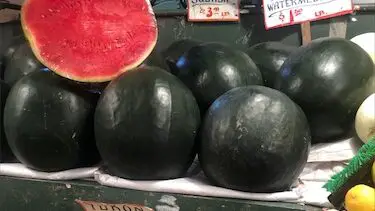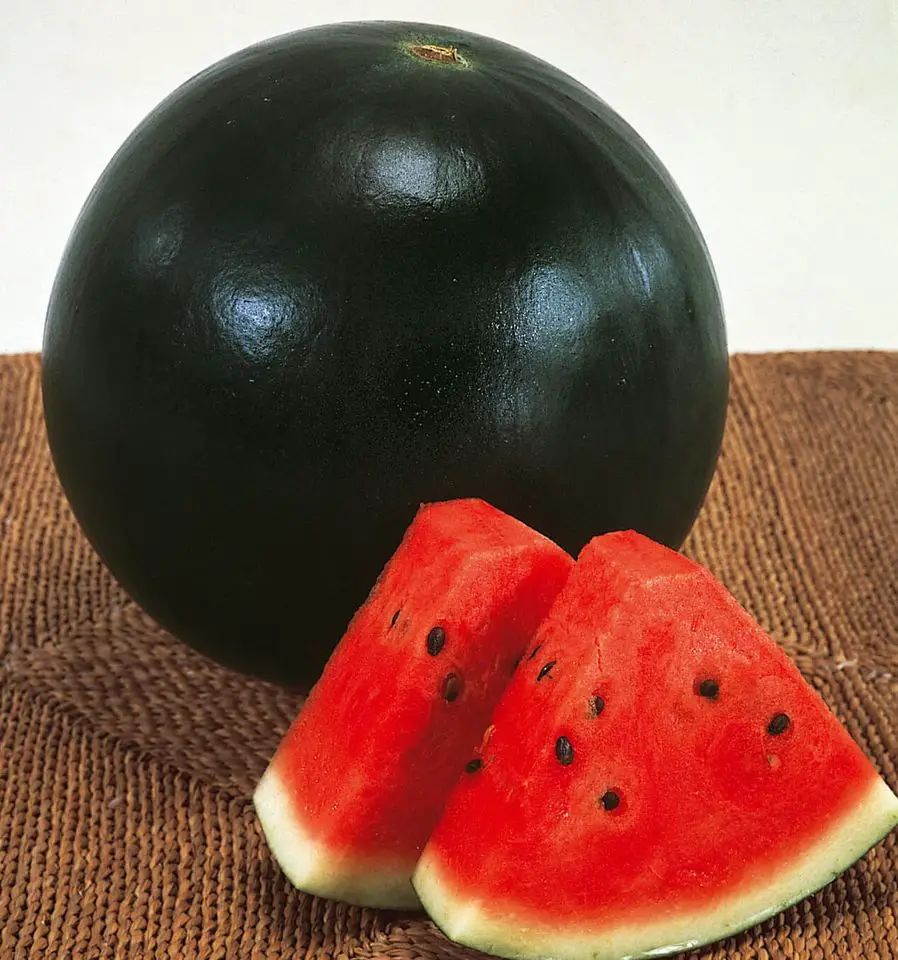We use affiliate links to run our site. When you buy through links on our site, we may earn an affiliate commission, without any added cost to you. Learn more
Are you ready to enjoy luscious, mouth-watering watermelons? Then the Black Diamond Watermelon, renowned for its enormous size and sweet, juicy flesh may be just what you are looking for.
Whether you’re a home gardener or managing a large-scale farm, this heirloom variety is sure to impress.
In this comprehensive guide, we’ll take you through the care and growing process of Black Diamond Watermelons. From planting the seeds to harvesting the fruit, we’ll provide you with expert tips and techniques to ensure a successful and bountiful harvest.
Get ready to savor the taste of summer as we dive into the world of Black Diamond Watermelons.
Preparing the Soil
Preparing the soil is crucial for the successful growth of black diamond watermelons.
Black diamond watermelons thrive in well-draining soil with a pH level between 6 and 7. Start by clearing the planting area of any weeds or debris.
Loosen the soil using a garden fork or tiller, breaking up any compacted areas. Incorporate organic matter such as compost or well-rotted manure to improve soil fertility and moisture retention.
Ensure the soil is warm enough before planting. Watermelons prefer soil temperatures around 70°F (21°C) for optimal growth.
If the soil is still cool, consider using black plastic mulch to help raise the temperature and promote earlier fruit development.
Planting Black Diamond Watermelons
Once the soil is prepared and temperatures are suitable, it’s time to plant your black diamond watermelon seeds.
Start by creating mounds or hills that are approximately 3 feet apart. Each hill should have 3 to 4 seeds planted at a depth of 1 inch. Space the seeds evenly within the hill to allow for proper growth.
Water the newly planted seeds gently to settle them into the soil. Maintain consistent moisture during the germination period, which typically takes 7 to 10 days. Once the seedlings emerge, thin them to the strongest one or two plants per hill.
Watering and Irrigation
Black diamond watermelons require consistent moisture throughout their growth cycle. Adequate watering is essential, especially during hot and dry periods.
Provide deep, thorough watering once a week, ensuring the soil is evenly moist but not waterlogged.
To conserve moisture and reduce weed competition, consider applying a layer of organic mulch around the watermelon plants.
Mulch also helps regulate soil temperature and prevent soil-borne diseases.
Important Tips For Growing Watermelons
Fertilizing and Nutrient Management
Proper fertilization is key to the healthy development of black diamond watermelons. Before planting, incorporate a balanced organic fertilizer into the soil based on soil test recommendations. This ensures the plants receive essential nutrients for growth.
During the growing season, apply a side dressing of nitrogen-rich fertilizer every three to four weeks. Nitrogen promotes leafy growth and enhances fruit development.
Be cautious not to over-fertilize, as excessive nitrogen can lead to vine growth at the expense of fruit production.
Pest and Disease Control
They can be susceptible to various pests and diseases. Common pests include aphids, cucumber beetles, and spider mites. Monitor your plants regularly and take prompt action if you notice any signs of infestation.
Implement cultural practices like crop rotation and intercropping with companion plants to deter pests.
Consider using row covers or netting to protect young plants from insects. If necessary, apply organic or chemical insecticides following the recommended guidelines.
Weed Management
Weeds compete with watermelons for nutrients, water, and sunlight. It’s essential to keep the planting area weed-free to ensure optimal growth.
Apply a layer of organic mulch around the plants to suppress weed growth and conserve soil moisture.
Regularly inspect the planting area and remove any weeds that emerge. Be cautious while weeding to avoid damaging the watermelon vines.
Hand weeding and shallow cultivation are effective methods for weed management.
The Lazy Gardener’s Ultimate Weapon to A Weed-free Garden.
Pruning and Training
Pruning and training watermelon vines can help improve airflow, reduce disease pressure, and enhance fruit development.
Remove any side shoots or suckers that emerge from the base of the plants. This directs the plant’s energy toward fruit production.
Consider providing support to the vines using trellises or stakes. This not only saves space but also prevents the fruits from touching the ground, reducing the risk of rot or pest damage.
Harvesting and Storing

Black diamond watermelons are ready for harvest when the fruits develop a deep, glossy color and have a hollow sound when tapped.
Check the color of the spot where the watermelon rested on the ground—the spot should turn creamy yellow. This indicates that the fruit is ripe and ready to be enjoyed.
To harvest the watermelons, use a sharp knife or pruning shears to cut the fruit from the vine, leaving a small stem attached. Avoid pulling or twisting the watermelons, as this can damage both the fruit and the plant.
After harvesting, store the watermelons in a cool, dry place for a few days to allow them to fully ripen. Once ripe, you can store them in the refrigerator to keep them fresh for a longer period.
Common Challenges and Troubleshooting
Growing black diamond watermelons can come with its fair share of challenges. Here are some common issues you may encounter and how to address them:
- Poor fruit set: Insufficient pollination or low bee activity can result in a poor fruit set. Encourage pollination by attracting bees to your garden with nectar-rich flowers or by hand-pollinating the flowers using a soft brush.
- Blossom end rot: Blossom end rot is a physiological disorder characterized by a dark, sunken area on the bottom of the fruit. It is caused by a calcium deficiency or irregular watering. Maintain consistent soil moisture and ensure adequate calcium levels through proper fertilization.
- Wilting: Wilting may occur due to various factors, including water stress, fungal diseases, or pest infestation. Check the soil moisture levels and adjust the watering accordingly. Treat any identified diseases or pests promptly to prevent further wilting.
Remember to closely monitor your plants throughout the growing season and promptly address any issues that arise. Regular observation and care are crucial for maintaining healthy black diamond watermelon plants.
Enjoying Black Diamond Watermelons
Once you’ve successfully grown and harvested your black diamond watermelons, it’s time to savor their delicious flavor. Here are a few ideas for enjoying these delectable fruits:
- Fresh watermelon slices: Cut the watermelon into juicy slices and enjoy them as a refreshing snack on a hot summer day.
- Watermelon salads: Incorporate diced black diamond watermelon into vibrant salads for a burst of sweetness. Combine it with fresh herbs, feta cheese, and a tangy dressing for a delightful summer salad.
- Watermelon smoothies: Blend black diamond watermelon chunks with yogurt and a touch of honey for a refreshing and hydrating smoothie.
- Watermelon sorbet: Freeze the watermelon flesh and blend it with a bit of lime juice and mint for a light and refreshing sorbet.
- Watermelon salsa: Dice watermelon, cucumber, jalapeño, and red onion, and toss them together with lime juice and cilantro for a flavorful salsa that pairs well with grilled meats or chips.
How long does it take for black diamond watermelons to mature?
Black diamond watermelons typically take around 80 to 90 days from planting to reach maturity, but this can vary depending on the specific variety and growing conditions.
Can I grow black diamond watermelons in containers?
Yes, it is possible to grow black diamond watermelons in containers. Choose a large container with good drainage and provide proper support for the vines. Ensure the container is placed in a sunny location and follow the same care guidelines as for garden-grown watermelons.
What are some common diseases that can affect black diamond watermelons?
Black diamond watermelons can be susceptible to diseases such as powdery mildew, downy mildew, and fusarium wilt. Monitor your plants regularly for any signs of disease, such as white powdery patches or yellowing leaves, and take appropriate measures such as applying fungicides or practicing crop rotation.
Do black diamond watermelons need cross-pollination?
Black diamond watermelons are primarily self-pollinating, meaning they don’t necessarily require cross-pollination by bees or other insects. However, having pollinators visit your garden can increase the chances of successful pollination and fruit set.
How do I know if a black diamond watermelon is ripe?
A ripe black diamond watermelon will have a deep, dark green skin that feels firm and smooth. The bottom spot where the watermelon rested on the ground should turn creamy yellow. Additionally, tapping the watermelon should produce a hollow sound.
Conclusion:
Growing and taking care of black diamond watermelons can be a rewarding experience. By following the proper techniques we discussed in this you can ensure healthy plant growth and a bountiful harvest.
With proper care, you’ll be able to enjoy the succulent sweetness of black diamond watermelons straight from your own garden.
We hope this article was helpful to you. Share the love and spread the excitement with your friends and family. Let them in on the secrets you’ve discovered, and watch their eyes light up with delight.
And remember, this is just the beginning of your horticultural adventure. Explore the vast array of articles on our site, each brimming with gardening wisdom and inspiration.
Amazon and the Amazon logo are trademarks of Amazon.com, Inc, or its affiliates.

Hi there! My name is Prasenjit and I’m an avid gardener and someone who has grown a passion for growing plants. From my hands-on experience, I have learned what works and what doesn’t. Here I share everything I have learned.
